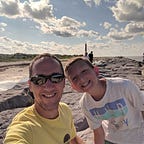Getting Started with .NET Core, Docker, and RabbitMQ — Part 1
The goal of this series is to introduce some of the technologies we use at Trimble MAPS. We’re going to build a web application that will accept HTTP messages from a client, publish them to a RabbitMQ message queue, then consume those messages from the queue. We’ll also use Docker to run each application in a container, and Docker-Compose to orchestrate the launch of all of our containers. If any of those terms are unfamiliar, don’t worry, each one will be explained as we approach it. The first part of this tutorial will focus on .NET Core.
Part 1: .NET Core (source code can be found on Github)
.NET Core is an open source software development framework, and effectively the successor to Microsoft’s .NET Framework. It’s been steadily growing in popularity among developers thanks to a few significant differences from previous iterations of .NET. Foremost among these is cross-platform support — applications can be built on Windows, Linux, or MacOS, and once built, will run on any of those platforms. The lightweight nature of .NET Core also make it an ideal choice for containerization. Combining those two attributes leads to a common industry use case — building apps on Windows, but running them in Linux containers to improve performance and reduce operating costs.
Let’s create two apps: a simple WebAPI to accept HTTP POST requests, and a console app to send those messages to our WebAPI. The only prerequisites for this are Visual Studio Code and the .NET Core…
